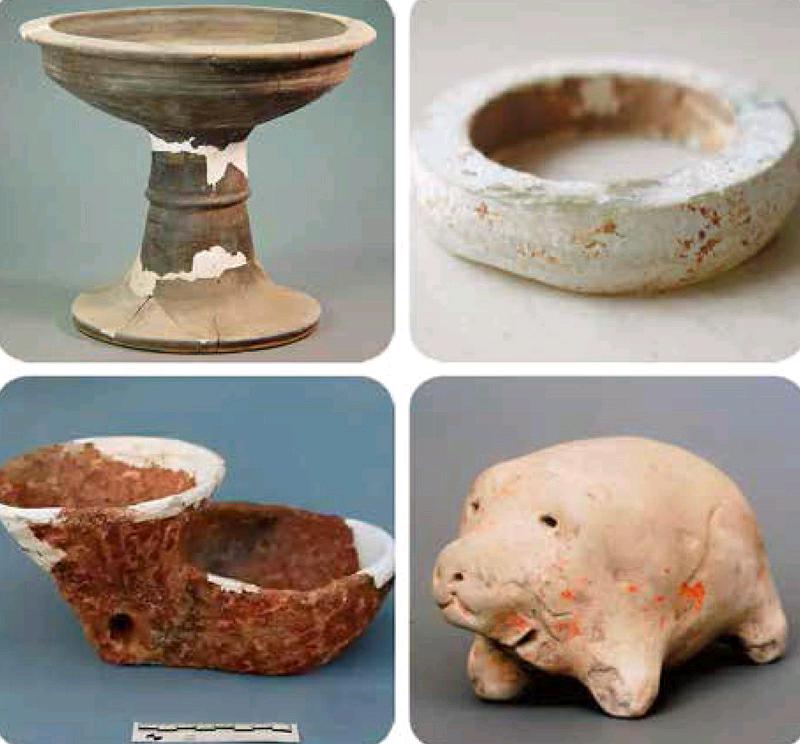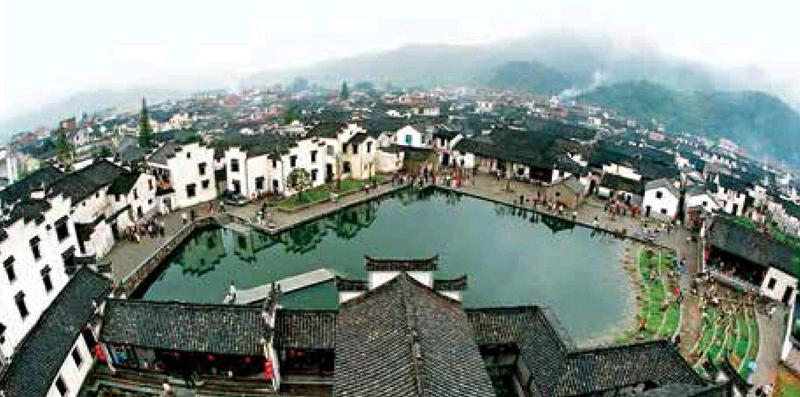啟封富陽六千年的秘密
魏水華
很多外地人對富陽的了解,最早可能來自于三國吳主、富春人氏孫權。這從一個側面道出了作為歷史文化名城富陽的千余年歷史。
再往前細究,秦王嬴政年間,已經設置富春縣。這段《史記》上的描述,是大部分人能夠查閱到的最早關于富陽有2000多年歷史的文獻記載。
日前,一個考古項目,把富陽的歷史拉長到6000年。
意外之喜:六千年的考古由來
發現考古遺存的地方叫“大源”,是個倚靠富春江邊的美麗小鎮。當地人告訴我,最近十幾年,鎮里的經濟搞得不錯,被選為浙江省小城鎮綜合改革試點鎮。
而這里與考古的淵源,肇始于2010年。
當時,杭黃高鐵正要施工,浙江省文物考古研究所接到任務,對沿線進行考古調查。沒想到,在進行了一定程度的鉆探、試掘后,在富陽大源鎮境內的亭山村瓦窯里自然村南面的地層剖面里采集到一些陶片和帶繩紋的磚瓦碎塊,它們的年代初步判斷不下數千年。考古人員確認,這里埋藏著一處古人生活遺址!
后來,杭黃高鐵工程整體擱置,后續搶救性考古發掘被延誤。2016年3月,省文物考古研究所聯合富陽文物館在瓦窯里遺址范圍內的高鐵施工工地北側重新啟動了搶救性考古發掘工作。
隨后的幾個月中,瓦窯里遺址出土了包括石鏃、石鉞、石錛、石斧在內的十余件良渚文化時期的重要文物。其中有一件鼎,下部有較典型的魚鰭形鼎足,腹部外表裝飾兩圈弱脊,具有河姆渡文化遺風。
那次考古發現表明,富陽人文歷史可以追溯至距今5000多年前的良渚文化時期。
誰曾想,這一年代紀錄,僅僅一年后,就再次被改寫。
“2016年的搶救性考古發掘,在時間上受到較大限制。”參與考古發掘的現場人員說。2017年4月底,他們再一次進駐瓦窯里自然村,對遺址進行了補充性考古發掘。
而這次發掘的成果,比之前都要豐富。
精心考據:六千年的生活細節
我來到考古現場的時候,考古工作已經接近尾聲,隊員們對所有出土的文物進行分類、標注和打包,對考古現場進行拍照記錄和保護。
幾十件出土文物中,大部分都是鼎、豆等形態的陶器,雖其貌不揚,但卻能看出濃厚的歷史積淀來。考古隊員們告訴我,很多器物已經年久,已經和豆腐渣一樣,修復難度非常大。
所以,除了田野考古之外,隊員們還在這兩個多月中進行了艱苦的文物修復工作,修復完成后,這些寶貝可能會成為復原五六千年前生活場景的鑰匙。
省文物考古所史前室主任孫國平接受了我的采訪。他介紹說,瓦窯里遺址的土地結構——根據碳14分析報告,這一區域的地層被分為四層,分別是現代的表土層、商周至唐宋時期的地層、良渚文化時期的地層和更早的馬家浜文化時期的地層。
這次最重大的發現,無疑來自于最底層:馬家浜文化是長江下游地區的新石器時代文化,年代約始于公元前5000年,延續了約1000年。
底層出土的文物,讓考古人員欣喜不已——雖然只是多角沿豆盤的一塊碎片(豆是古代用來放食物的器皿)和一塊牛鼻形的器耳,但對于佐證富陽的歷史有重要意義。根據專家可靠判斷,它們是馬家浜文化晚期的典型遺物,距今6000年左右。
它們都是6000年前,先民日常生活用的“鍋碗瓢盆”。
宏大視野:六千年的社會意義
事實上,在富陽以往進行的考古發掘中,也在多個鄉鎮發現過良渚文化時期零星遺物。而這次在瓦窯里的考古發掘,足以說明在此地存在著一片古代墓地。“可以證明在良渚文化早期,有一部分先民已經在富陽繁衍生息了,也表明良渚文化范圍自早期開始就已拓展至浙西南沿江(富春江)山地丘陵區。”孫國平認為,這些先民在富春江南岸山腳下的坡地(臺地)上生產、生活,也許他們還組成了小型的村落。這是目前考古發現的富陽境內最早的先民生活場所,是最可靠的富陽歷史文化的源頭。
孫國平表示,“從出土器物來看,這是一個較高規格的墓葬。”其中的一件陶器,形狀就像一個漏斗和一個小碗的結合體,隱約能看到古樸紋飾,“這是一個過濾器,可能是墓主人生前用于過濾酒糟的,但它既具有明顯的地方文化特征,又與良渚文化核心區的同類器基本一致。”
聯系去年發現的墓葬,就會發現,這是3座幾乎挨在一起的墓葬。根據隨葬物品,可以判斷出中間的那個墓主人是男性,其左右兩邊的為女性。中間墓葬出土的石鉞、石錛都是生產工具,在原始時代通常為男性所用,而兩側的每一座墓葬中均有小件裝飾玉器和一件石紡輪出土,它們通常為女性所用。
根據已有的考古研究成果,在距今四五千年前的良渚文化時期,大致已形成了男主外、女主內的父權家庭的社會關系。“那么,當時的社會有沒有可能一部分人是一夫兩妻呢?瓦窯里的發現值得人們進一步關注。”孫國平拋出了一個饒有趣味的說法。
這次富陽的考古發現,不僅拓寬了當地乃至整個浙東北地區的歷史寬度,更作為重要組成部分印證了“浙江7000年”的歷史。書法、劍、曲、僧、琴、舟、茶、宅、藏書、青瓷,活在這些載體里的浙江,讓人們看到江7000年文化歷史的生命軌跡和保留到今天的新鮮記憶。
Fuyang, now a district of Hangzhou, is probably known to most people as the birthplace of Sun Quan, the king of Wu Kingdom during the Three Kingdoms period which spanned the 3rd century AD. A scholar of history may know more: Fuyang as it is known now was Fuchun County during the reign of the First Emperor of the Qin Dynasty (221-207BC). Latest archaeological finds, however, have pushed the history of Fuyang to 6,000 years ago.endprint
The first dig of the archaeological discovery started in 2010 in Dayuan, a rural town on Fuchun River. Archaeologists were instructed to take a look at the planned route of a railway between Hangzhou and Huangshan Mountains. Unexpectedly, they unearthed some pottery shards and some brick and tile shards imprinted with the pattern of rope at Wayaoli, a natural village in Dayuan town. The archaeologists tentatively concluded that it was a site of ancient people.
The excavation was called off, however, as the railway project was suspended. As the railway project kicked off again, archaeologists came back in March 2016 to the village. In the following months, they unearthed about a dozen of stone objects such as axes and arrow heads. One of the objects was a , which looks like the objects unearthed at the Hemudu Culture. The dig in March 2016 indicated that the history of Fuyang could be traced back at least to the Liangzhu Culture of 5,000 years ago.
From April to July 2017, archaeologists came back to the village again for another dig and this dig produced an unprecedented number of pottery objects. A big part of these unearthed objects are and , special vessels. The experts had a hard time to restore them as they had deteriorated badly.
Archaeologists are happy to conclude that the bottom layer of the site can be traced to the Majiabang Culture, a regional Neolithic subculture that started 5,000 years BC and lasted about 1,000 years. In other words, the excavation indicates that people lived in what is Fuyang now over 6,000 years ago.
In fact, archaeological studies in Wayaoli and other places across Fuyang indicate that Fuyang was inhabited in the early years of the Liangzhu Culture, which flourished in the northern suburb of Hangzhou whereas Fuyang is 30 kilometers southwest of Hangzhou. The ancient people in Fuyang had connection with the Liangzhu Culture as the objects they used in everyday life resemble those unearthed in the sites of the Liangzhu Culture. The connection indicates that Liangzhu Culture was spreading out even in its early phase and some ancients came to the hilly areas along Fuchun River. These ancient people might have settled down and formed a village in whats now known as Fuyang. Objects unearthed in Wayaoli comprise the most ancient and reliable evidence of the civilization in Fuyang.
The site in Wayaoli Village might contain a cemetery where some important people were buried. Archaeologists know that the Liangzhu culture was a patriarchal system, but they are not certain whether a family had one husband and two wives back then. The archaeological excavation at Wayaoli indicates that in one tomb a man was buried with two women. This question has come out of the excavation and archaeologists expect to find more to answer it in the future.
Archaeologically, Zhejiang has a history of 7,000 years and Fuyang has a history of 6,000. The evidence unearthed at Wayaoli, Fuyang has pushed back the horizons in the whole northeastern area of the province for further historical studies. Calligraphy, sword, music, Buddhism, Qin, boat, tea, house, books, and celadon are ancient hallmarks of Zhejiang. They emerged in the history of the province in different ages, indicating the width and breadth of the 7,000-year civilization in this cultured land.endprint

